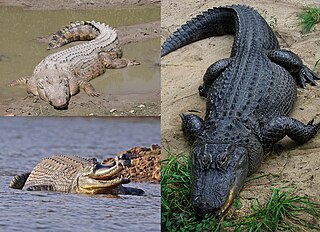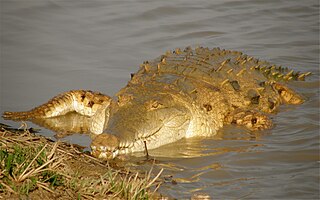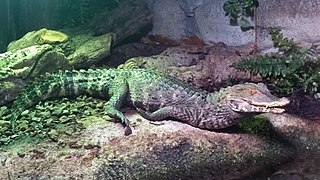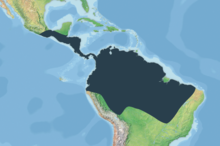
The family Alligatoridae of crocodylians includes alligators, caimans and their extinct relatives.

Crocodiles or true crocodiles are large semiaquatic reptiles that live throughout the tropics in Africa, Asia, the Americas and Australia. The term crocodile is sometimes used even more loosely to include all extant members of the order Crocodilia, which includes the alligators and caimans, the gharial and false gharial among other extinct taxa.

Crocodilia is an order of mostly large, predatory, semiaquatic reptiles known as crocodilians. They first appeared 94 million years ago in the Late Cretaceous period and are the closest living relatives of birds, as the two groups are the only known survivors of the Archosauria. Members of the order's total group, the clade Pseudosuchia, appeared about 250 million years ago in the Early Triassic period, and diversified during the Mesozoic era. The order Crocodilia includes the true crocodiles, the alligators and caimans, and the gharial and false gharial. Although the term crocodiles is sometimes used to refer to all of these, crocodilians is a less ambiguous vernacular term for members of this group.

An alligator, or colloquially gator, is a large reptile in the genus Alligator of the family Alligatoridae of the order Crocodilia. The two extant species are the American alligator and the Chinese alligator. Additionally, several extinct species of alligator are known from fossil remains. Alligators first appeared during the late Eocene epoch about 37 million years ago.

Caiman is a genus of caimans within the alligatorid subfamily Caimaninae. They inhabit Central and South America. They are relatively small sized crocodilians, with all species reaching lengths of only a couple of meters and weighing 6 to 40 kg on average.

The American alligator, sometimes referred to as a gator or common alligator, is a large crocodilian reptile native to the Southeastern United States and a small section of northeastern Mexico. It is one of the two extant species in the genus Alligator, and is larger than the only other living alligator species, the Chinese alligator.

The saltwater crocodile is a crocodilian native to saltwater habitats, brackish wetlands and freshwater rivers from India's east coast across Southeast Asia and the Sundaic region to northern Australia and Micronesia. It has been listed as Least Concern on the IUCN Red List since 1996. It was hunted for its skin throughout its range up to the 1970s, and is threatened by illegal killing and habitat loss. It is regarded as dangerous to humans.

The yacare caiman, also known commonly as the jacare caiman, Paraguayan caiman, piranha caiman, red caiman, and southern spectacled caiman, is a species of caiman, a crocodilian in the family Alligatoridae. The species is endemic to Argentina, Bolivia, Brazil, and Paraguay. Brown in color and covered with dark blotches, males grow to a total length of 2–3 m and weigh around 40–50 kg (88–110 lb); while females grow to 1.4 m long and about 15–20 kg (33–44 lb). Typical habitats of this caiman include lakes, rivers, and wetlands. Its diet primarily consists of aquatic animals, such as snails, and occasionally land vertebrates. Mating occurs in the rainy season and eggs hatch in March, with young fending for themselves as soon as they hatch. The yacare caiman was hunted heavily for its skin to use for leather in the 1980s, which caused its population to decrease significantly. However, trading restrictions placed since have caused its population to increase. Its population in the Pantanal is about 10 million, and it is listed as least concern on the IUCN Red List.

The black caiman is a crocodilian reptile endemic to South America. With a maximum length of around 5 to 6 m and a mass of over 450 kg (1,000 lb), it is the largest living species of the family Alligatoridae, and the third-largest crocodilian in the Neotropical realm. True to its common and scientific names, the black caiman has a dark greenish-black coloration as an adult. In some individuals, the pigmentation can appear almost jet-black. It has grey to brown banding on the lower jaw; juveniles have a more vibrant coloration compared to adults, with prominent white-pale yellow banding on the flanks that remains present well into adulthood. The banding on young animals helps with camouflage by breaking up their body outline, on land or in water, in an effort to avoid predation. The morphology is quite different from other caimans but the bony ridge that occurs in other caimans is present. The head is large and heavy, an advantage in catching larger prey. Like all crocodilians, caimans are long, squat creatures, with big jaws, long tails and short legs. They have thick, scaled skin, and their eyes and noses are located on the tops of their heads. This enables them to see and breathe while the rest of their bodies are underwater.

The Nile crocodile is a large crocodilian native to freshwater habitats in Africa, where it is present in 26 countries. It is widely distributed in sub-Saharan Africa, occurring mostly in the eastern, southern, and central regions of the continent, and lives in different types of aquatic environments such as lakes, rivers, swamps, and marshlands. Although capable of living in saline environments, this species is rarely found in saltwater, but occasionally inhabits deltas and brackish lakes. The range of this species once stretched northward throughout the Nile River, as far north as the Nile Delta. Lake Rudolf in Kenya has one of the largest undisturbed populations of Nile crocodiles. Generally, the adult male Nile crocodile is between 3.5 and 5 m in length and weighs 225 to 750 kg. However, specimens exceeding 6.1 m (20 ft) in length and 1,000 kg (2,200 lb) in weight have been recorded. It is the largest freshwater predator in Africa, and may be considered the second-largest extant reptile in the world, after the saltwater crocodile. Size is sexually dimorphic, with females usually about 30% smaller than males. The crocodile has thick, scaly, heavily armoured skin.

The American crocodile is a species of crocodilian found in the Neotropics. It is the most widespread of the four extant species of crocodiles from the Americas, with populations present from South Florida, the Caribbean islands of Cuba, Jamaica, Hispaniola, and the coasts of Mexico to as far south as Peru, Ecuador, Colombia, and Venezuela.

The broad-snouted caiman is a crocodilian in the family Alligatoridae found in eastern and central South America, including southeastern Brazil, northern Argentina, Uruguay, Paraguay, and Bolivia. It is the second largest caiman and the third largest alligatorid. It is found mostly in freshwater marshes, swamps, and mangroves, usually in still or very slow-moving waters. It will often use man-made cow ponds.

The Orinoco crocodile is a critically endangered crocodile. Its population is very small, and they can only be found in the Orinoco river basin in Venezuela and Colombia. Extensively hunted for their skins in the 19th and 20th centuries, it is one of the most endangered species of crocodiles. It is a very large species of crocodilian; males have been reported up to 6.8 m in the past, weighing over 900 kg (2,000 lb), but such sizes do not exist today, 5.2 m being a more widely accepted maximum size. A large male today may attain 4.2 m in length and can weigh up to 450 kg (1,000 lb), while females are substantially smaller with the largest likely to weigh around 225 kg (496 lb). Sexual dimorphism is not as profound as in other crocodilian species. The coloration is light even in adults.

The St. Augustine Alligator Farm Zoological Park is one of Florida's oldest continuously running attractions, having opened on May 20, 1893. It has 24 species of crocodilians, and also a variety of other reptiles, mammals and birds, as well as exhibits, animal performances and educational demonstrations.

Cuvier's dwarf caiman is a small crocodilian in the alligator family from northern and central South America. It is found in Bolivia, Brazil, Colombia, Ecuador, French Guiana, Guyana, Paraguay, Peru, Suriname, Trinidad and Venezuela. It lives in riverine forests, flooded forests near lakes, and near fast-flowing rivers and streams. It can traverse dry land to reach temporary pools and tolerates colder water than other species of caimans. Other common names for this species include the musky caiman, the dwarf caiman, Cuvier's caiman, and the smooth-fronted caiman. It is sometimes kept in captivity as a pet and may be referred to as the wedge-head caiman by the pet trade community.

The smooth-fronted caiman, also known as Schneider's dwarf caiman or Schneider's smooth-fronted caiman, is a crocodilian from South America, where it is native to the Amazon and Orinoco Basins. It is the second-smallest species of the family Alligatoridae, the smallest being Cuvier's dwarf caiman, also from tropical South America and in the same genus. An adult typically grows to around 1.2 to 1.6 m in length and weighs between 9 and 20 kg. Exceptionally large males can reach as much as 2.3 m (7.5 ft) in length and 36 kg (79 lb) in weight.

A caiman is an alligatorid belonging to the subfamily Caimaninae, one of two primary lineages within the Alligatoridae family, the other being alligators. Caimans are native to Central and South America and inhabit marshes, swamps, lakes, and mangrove rivers. They have scaly skin and live a fairly nocturnal existence. They are relatively small-sized crocodilians with an average maximum weight of 6 to 40 kg depending on species, with the exception of the black caiman, which can grow more than 4 m (13 ft) in length and weigh in excess of 1,000 kg. The black caiman is the largest caiman species in the world and is found in the slow-moving rivers and lakes that surround the Amazon basin. The smallest species is the Cuvier's dwarf caiman, which grows to 1.2 to 1.5 m long. There are six different species of caiman found throughout the watery jungle habitats of Central and Southern America. The average length for most of the other caiman species is about 2 to 2.5 m long.

A crocodile farm or alligator farm is an establishment for breeding and raising of crocodilians in order to produce crocodile and alligator meat, leather from crocodile and alligator skin, and other goods. Many species of both alligators and crocodiles are farmed internationally. In Louisiana alone, alligator farming is a $60 to $70 million industry. Most crocodile farms are located in Thailand.
Extinct or Alive is an American wildlife documentary television programme produced for Animal Planet by Hot Snakes Media of New York City, the United States. It is hosted by wildlife biologist and television personality Forrest Galante, who travels to different locations around the globe to learn about possibly extinct animals and whether or not there is a chance that they may still be extant. The series has been involved in the possible rediscovery of eleven animals, namely the Zanzibar leopard, the Pondicherry shark, the Fernandina Island Galápagos tortoise, the Miller's grizzled langur, the Cape lion, the Malagasy hippopotamus, the Yangtze giant softshell turtle, Rio Apaporis caiman, Whitetip weasel shark, Ornate sleeper-ray and the Flapnose houndshark.

























